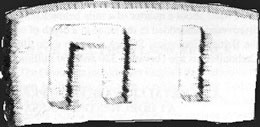|
The Museum of Forbidden Archeology
Anomalous Discoveries From The California Gold Mines
In 1849, gold was discovered in the gravels of ancient riverbeds on the slopes of the Sierra Nevada Mountains in central California, drawing hordes of rowdy adventurers to places like Brandy City, Last Chance, Lost Campe, You Bet, and Poker Flat. Occasionally, the miners would find stone artifacts, and more rarely, human fossils.
Altogether, miners found hundreds of stone implements - mortars, pestles, platters, grinders, and so forth. Many of the specimens found their way into the collection of Mr. C.D. Voy, a part-time employee of the California Geological Survey. Voy’s collection eventually came into the possession of the University of California, and the most significant artifacts were reported to the scientific community by J.D. Whitney, then the state geologist of California.
J.D. Whitney thought the geological
evidence indicated the auriferous--or gold-bearing-- gravels, and
the sophisticated stone tools found in them, were at least Pliocene
in age. But modern geologists think some of the gravel deposits,
which lie beneath volcanic formations, are much older. The majority of gold-bearing gravels were laid down in stream channels during the Eocene and Early Oligocene. During the Oligocene, Miocene, and Pliocene, volcanic activity in the same region covered some of the auriferous gravels with deposits of rhyolite, andesite, and latite.
In particular, widespread andesitic
mudflows and conglomerates were deposited during the Miocene. These
attained a
Over the course of time, rivers carved
deep channels up to a couple of thousand feet below the level of the
prevolcanic gravels. This allowed Gold Rush miners to reach the
auriferous gravels by digging horizontal tunnels into the sides of
the channels. The advanced stone tools found in these tunnels could
be from Eocene to Pliocene in age. California State Geologist J.
D. Whitney (above) concluded that modern man existed in
California previous to the cessation of volcanic activity in the
Sierra Nevada.
Anomalous Finds at Tuolumne Table Mountain
Discoveries from the auriferous gravels
just above the bedrock are probably 33.2 to 55 million
years old.
The more important discoveries from Table Mountain add up to a
considerable weight of evidence. J.D. Whitney personally examined a
collection belonging to Dr. Snell, consisting of stone spoons,
handles, spearheads, and a human jaw - all found in the auriferous
gravels beneath the latite cap of Tuolumne Table Mountain. Whitney
remarked that all the human fossils uncovered in the gold-mining
region, including this one, were of the anatomically modern type.
Mortar and Pestle from Table Mountain
On August 2, 1890, J.H. Neale signed the following statement about his discoveries:
The Calaveras Skull
It was examined by J.D. Whitney, State Geologist of California, who presented a report on the Calaveras skull to the California Academy of Sciences on July 16, 1866, affirming that it was found in Pliocene strata. This discovery caused a huge sensation in America and many believed it was a hoax.
Broken stone pestle from Table Mountain
Becker stated:
Becker added:
From this description and the modern
geological dating of the Table Mountain strata, it is apparent that
the object was over 9 million years old.
William H. Holmes Challenges J.D. Whitney
Holmes also discredited Whitney’s dating of anomalous stone tools discovered at the California gold mines, asserting they were from the local Digger Indians. One might ask why Holmes and others were so determined to discredit Whitney’s evidence for the existence of Tertiary humans. The following statement by Holmes provides an essential clue:
In other words, if the facts do not fit
the favored theory, the facts, even an imposing array of them, must
go.
Figure A2.9
Grooved Sphere from South Africa A metallic sphere from South Africa with three parallel grooves around its equator (photo courtesy of Roelf Marx). The sphere was found in a Precambrian mineral deposit, said to be 2.8 billion years old. [p. 813, Forbidden Archeology]
Fig. A2.3
Ancient Coin from Illinois This coinlike object, from a well boring near Lawn Ridge, Illinois, was reportedly found at a depth of about 114 feet below the surface (Winchell 1881, p. 170). According to information supplied by the Illinois State Geological Survey, the deposits containing the coin are between 200,000 and 400,000 years old. [p. 801, Forbidden Archeology]
Figure A2.1
Mysterious Letters from a Quarry Raised letterlike shapes found inside a block of marble from a quarry near Philadelphia, Pennsylvania (Corliss 1978, p. 657; American Journal of Science 1831, vol. 19, p. 361). The block of marble came from a depth of 60-70 feet in strata dated 500-600 million years old. [p. 797, Forbidden Archeology]
Reck’s Skeleton The first significant African discovery related to human origins occurred in 1913 when Professor Hans Reck, of Berlin University, found a human skeleton in the upper part of Bed II at Olduvai Gorge, Tanzania. Modern dating methods give a late Early Pleistocene date of around 1.15 million years for this site.
Reck said,
The skeleton was distorted by compression from the weight of substantial accumulation of sediment in the overlying strata. W. O. Dietrich, writing in 1933, stated that this feature of the skeleton argued against its being a recent, shallow burial. George Grant MacCurdy, a leading anthropologist from Yale University, considered Reck’s discovery to be genuine. [pp. 630-631, Forbidden Archeology]
Fig. 6.4 Castenedolo Skull This anatomically modern human skull (Sergi 1884, plate 1) was found in 1880 at Castenedolo, Italy. The stratum from which it was taken is assigned to the Astian stage of the Pliocene (Oakley 1980, p. 46). According to modern authorities (Harland et al, 1982, p. 110), the Astian belongs to the Middle Pliocene, which would give the skull an age of 3-4 million years. [p. 424, Forbidden Archeology]
Javaman Thighbone In August 1892, Eugene Dubois discovered a fossilized humanlike femur on the bank of the Solo River in central Java, near the village of Trinil. 45 feet from this location he found a skullcap and molars. Dubois believed the molars, skull, and femur all came from the same being. However, the fact that these bones were found 45 feet from the place where the skull was unearthed, in a stratum containing hundreds of other animal bones makes doubtful the claim that both the thighbone and the skull actually belonged to the same creature or even the same species.
In 1895 Dubois presented his findings to the Berlin Society for Anthropology, Ethnology, and Prehistory. The president of the society, Dr. Virchow declared that the femur was human and the skull belonged to an ape. Late in his life, Dubois concluded that the skullcap belonged to a large gibbon, an ape not considered by evolutionists to be closely related to humans. But this concept of the "missing link" is still widely promoted today!
[pp. 464-465, Forbidden Archeology]
|
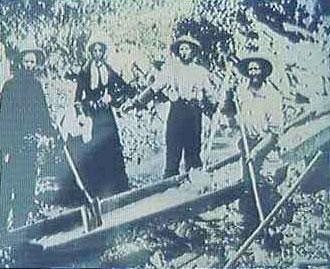
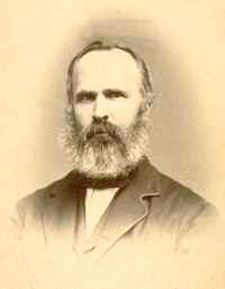
 considerable
thickness, varying from more than 3,000 feet along the crest of the
Sierras to 500 feet in the foothills. The volcanic flows were so
extensive that they almost completely buried the bedrock landscape
of the northern Sierra Nevada mountain region.
considerable
thickness, varying from more than 3,000 feet along the crest of the
Sierras to 500 feet in the foothills. The volcanic flows were so
extensive that they almost completely buried the bedrock landscape
of the northern Sierra Nevada mountain region. 
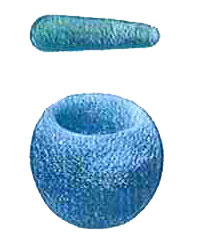
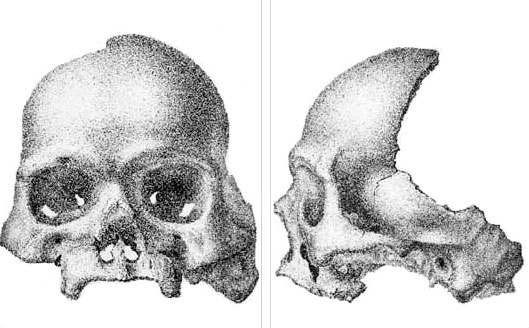
 Survey
of the Fortieth Parallel, and a respected geologist, was conducting
research at Tuolumne Table Mountain.
Survey
of the Fortieth Parallel, and a respected geologist, was conducting
research at Tuolumne Table Mountain. 


